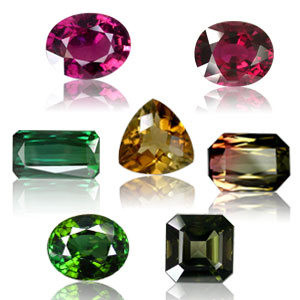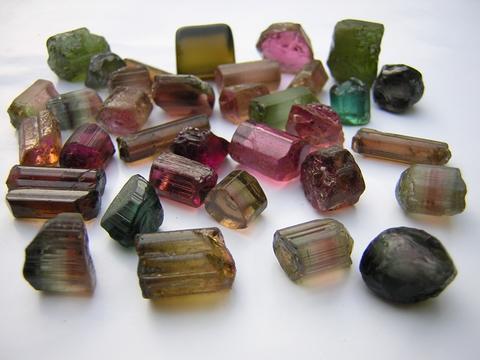Tourmaline has more varied colors than any other gemstone. With more than 100 hues available. Tourmaline's almost limitless colors, can resemble almost any other gemstone. Although red, green, and multicolored are its most famous colors. Scientifically, tourmaline is not a single mineral, but a group of minerals related in physical and chemical properties.
The mineral elbaite is a member of the tourmaline group responsible for almost all the gem varieties. Although elbaite is a separate member of the tourmaline group, and occurs in all different colors, the term elbaite refers only to green tourmaline in the gem trade. The other color forms of elbaite have their own variety names on the gem market.

There are three other members of the group. Dravite, Schorl, and Liddicoatite. These varieties are seldom used as gems. Dravite is brown in color, and is rarely transparent enough to be used as a gem. They can be heat-treated to lighten their dark color and are sometimes cut into gems. Schorl, which is dark gray to black, basically has no gem use. With the exception of being used in it's natural crystal form. Liddicoatite is too rare to be used extensively, although its popularity as a gemstone is increasing. More rare members of this group are in the Silicates Class, under Cyclosilicates
Rubellite is the term used for red or pink tourmaline, and indicolite is the term used for blue tourmaline. A recent trend in the gem market. Is to call all tourmalines by the color designation as opposed to variety name. For example "Rubellite" would be "red tourmaline"
Current Gem Trade Names:
Anchorite:
A Colorless variety of tourmaline
Bi-color:
Bi-color tourmalines are very unique. As there are no other gems that resemble them. Only Ametrine, a Bi-color mixture of purple amethyst and yellow citrine, comes close. But this gem has characteristic colors that would not be confused with Bi-color tourmalines
Cat's Eye:
Are pink and green tourmalines from certain localities that contain tiny, parallel inclusions, causing them to display a strong cat's eye effect when polished. Such stones are usually cut as cabochons.
Chrome:
A rare type of tourmaline from Kenya, Zambia, Namibia and Tanzania. It comes in very rich green colors. Caused by Chromium or Vanadium oxides. Chromium is same element which causes the green in emerald. Chrome Tourmaline was first mined in Tanzania in the 1960's. This Tourmaline can have the color of top grade Emerald and is much more durable.
Dravite:
A brown variety of tourmaline
Elbaite:
(Green Tourmaline) This is the most recognized of the Tourmaline colors. Green Tourmalines are typically eye clean stones. Most are cut in rectangular shapes. Shades range from a pastel Green to a deep, vibrant Green.
Indicolite:
The finest Blue Tourmalines are medium dark Blue, close to the color of Blue Sapphire. Sources for Indicolite are Sri Lanka, Brazil, Madagascar, California and Maine. Indicolite is typically a clean Gemstone, seldom with eye visible inclusions
Orange & Yellow:
These colors don't seem to have any real well known commercial names. But Tourmaline does come in these colors and many shades in between.
Paraiba:
Or Neon Tourmaline. First called "Electric" then "NEON." This gemstone was discovered in 1989. It's brilliant blues and greens are the most vivid ever seen. It is the only Tourmaline in the world that contains Copper. A recent study by the German Foundation for Gemstone Research also discovered a surprisingly high gold content, 8.6 parts per million. The term "NEON" defiantly describes the colors of this gem. It's only location is near the village Sao Jose de Batalha. In the state of Paraiba, Brazil. The mine shafts are deep, hand-excavated tunnels, with very thin veins. This means the supply will always be limited, rare and expensive.
Pink:
Pink Tourmaline has become a favorite for mounting because it is available in so many shades, ranging from light pink to hot pink and many shades in between. Gemologists think that natural irradiation produces the Pink, Red and Violet colors in Tourmaline. To get the color of the very hot pinks. You can expect it to be Cobalt treated.
Rubellite:
Called Rubellite because the deepest shades appear Ruby Red. The darker reddish colors tend to have more natural inclusions than the other Tourmaline colors because they are formed near the center of the crystal pocket and receive more stress and pressure during formation. Eye clean Rubellite is one of the most expensive of the Tourmalines. Since most Rubellite has visible inclusions. Clean Rubellite is very rare, so if you see a super clean stone it's probably a radiated Pink Tourmaline or a Rhodalite Garnet.
Schorl:
black variety of tourmaline
Watermelon:
Or Tri-color are Green and Red with a White separation. The vast majority of the stones are obscure or heavily included. Clean Gems are much more expensive. Definitely one-of-a-kind Gems. Watermelon Tourmaline is a highly valued Collectors Gemstone.

General Information:
Almost every color of tourmaline can be found in Brazil, especially in Minas Gerais and Bahia. Pink and green colors are particularly popular. In addition to Brazil, tourmaline is also mined in Tanzania, Kenya, Madagascar, Mozambique, Namibia, Afghanistan, Pakistan, Sri Lanka, and California and Maine in the United States. Maine produces beautiful sherbet colors of tourmaline and spectacular mint greens. California is known for perfect pinks, as well as beautiful bicolor.
Tourmalines are most often, pencil thin. Because of this long narrow crystal shape.Tourmaline is often cut in long rectangular shapes. This long narrow cut has been called "Tourmaline Cut" More and more, the Crystals them selves are being set in jewelry.
Tourmaline crystals are often cracked and flawed, especially in the Red, Pink and BI-colors. Clean stones of 10 Carats or more in these colors command a premium price. The Green and Blue colors are generally very clean.
Tourmaline exhibits the interesting electrical properties of pyroelectricity and piezoelectricity. When heated or rubbed, it attracts dust and dirt particles. This is caused by its atomic structure, which causes it to generate an electrical charge when heated or rubbed.
The vivid colors like Bubble Gum Pink in Tourmaline is Heat or Cobalt Irradiation treated. To enhance and stabilize the color. Heat Treatment can enhance the color of some tourmalines. Some greenish stones can be made deep green, some reddish brown stones can be made red, and some light pink stones can be made colorless. Some lighter colored stones can also be made into a deeper hue, and dark, transparent Dravite can be made lighter.
All colored tourmaline gems display pleochroism, meaning their color changes when viewed at different angles. In some gems, this effect is hardly noticeable, while in others it is strongly apparent. Gemstone cutters must take this into account when cutting a tourmaline, so the finished gem brings out its best color.